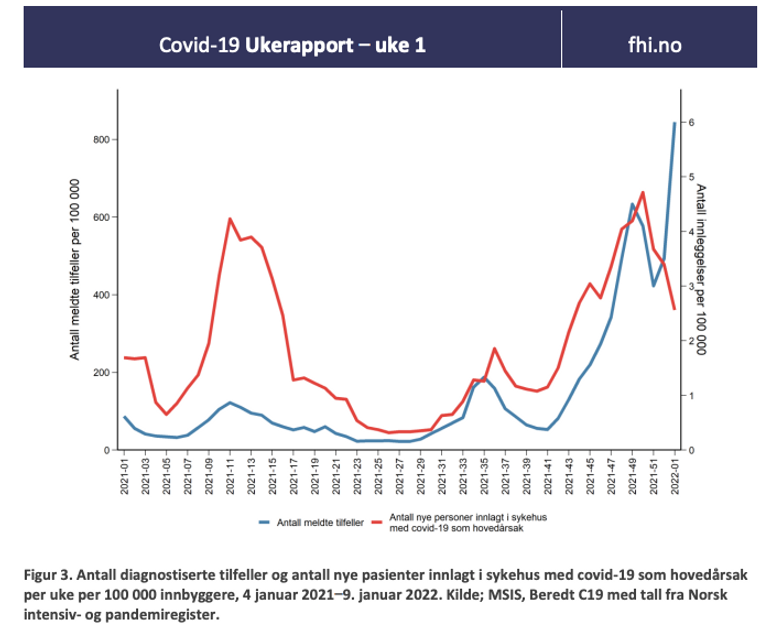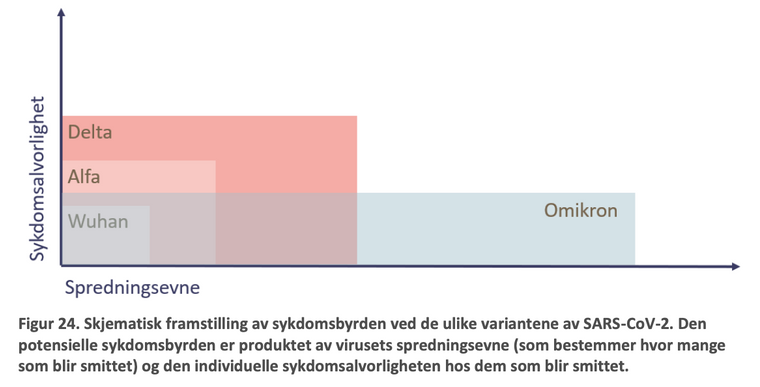What we know about Omikron this far.

Faktisk.no: By Sofie Svanes Flem. Published: 14.01.2022. Updated: 14.01.2022.
Dette vet vi om omikron så langt (Norwegian)
Omikron reduces the risk of serious illness and hospitalizations. But there is still a lot of uncertainty about what an Omikron-driven wave of infections will look like.
Over the last couple of weeks, omikron has taken over as the dominant virus variant in Norway. Omikron has now displaced delta, writes the National Institute of Public Health (NIPH) in its risk report on 12 January.
At the same time, ever new studies have provided bit by bit of knowledge, and we know more about the virus variant now than when the government introduced measures in December.
- Many of the assumptions one had in the beginning have gradually been confirmed by new studies and pieces of information. Although most of the studies have not been peer-reviewed yet, says vaccine researcher Even Fossum at Rikshospitalet.
Peer review means that other researchers, who are experts in the field, review the method used and check whether the results are correct. This is a process that can take many months. During the corona pandemic , researchers have therefore begun to share their research before it is peer-reviewed.
What do we know - and what do we not know - about the virus variant that first appeared in South Africa in November 2021? We have asked the vaccine researcher to summarize the most important knowledge we have at present.
To make a long story short
- Omikron offers a lower risk of serious illness and hospitalizations, but the figures vary from country to country.
- Omikron spreads faster than previous variants of SARS-CoV-2, but how much more contagious omikron is is not entirely clear.
- Exactly how much milder the virus is - and how much faster it spreads - varies between different studies and countries.
- NIPH has estimated that the risk of hospitalization in Norway is 69 per cent lower with omikron than with delta.
- The vaccines appear to protect less against omicron infection than previous variants, but still appear to protect well against serious illness.
More upper respiratory tract infection
- Omikron is more contagious but gives fewer cases of serious illness. This has been fairly well confirmed by various countries and studies now, the researcher sums up.
It is not entirely clear why this is so. Some studies have shown that the omicron primarily infects cells in the upper part of the airways, Fossum explains.
- Infection in the upper part of the respiratory tract often causes milder disease, but can also lead to greater spread of the virus through the mouth and nose. The delta variant, on the other hand, seems to more effectively infect cells further into the lungs, which can contribute to a more serious disease picture.

Even Fossum is a vaccine researcher at the Department of Immunology and Transfusion Medicine at Rikshospitalet. Photo: Ragnhild Eskeland.
Data on this were first reported by researchers at the University of Hong Kong. The study showed that after 24 hours, the omicron virus copied itself 70 times faster in the upper respiratory tract than the delta, but ten times slower in the lungs.
A preprint from Imperial College in the UK showed greater spread of omicron than participating in cell samples from the upper respiratory tract. Both of these studies have been done on cell samples.
- Studies on mice have also pointed in that direction. But we need more studies, says Fossum, who has not yet seen studies that have shown more virus in the upper respiratory tract in patients with omicron.
Milder disease
Omikron offers a lower risk of serious illness and hospitalizations, but the figures vary from country to country.
Data from the United Kingdom have indicated that the risk of hospitalization is halved by omicron, while figures from South Africa have indicated that there is an 80 per cent lower risk of hospitalization.
- We now see several countries with very high infection rates where the number of admissions has not risen as sharply in relation to previous waves of infection. This is probably a result of omicron giving milder disease, but also that many more have been vaccinated and thus well protected against serious disease, says Fossum.
A preliminary analysis from FHI estimates that the risk of hospitalization is 69 per cent lower with omikron than with delta.
Infectious
Omikron spreads faster than previous variants of SARS-CoV-2, but how much more contagious omikron is is not entirely clear, according to Fossum.
- A new Danish study has compared the spread of infection within households for omikron and the delta variant, and sees that omikron spreads to a greater extent to fully vaccinated, says the vaccine researcher.
The ability of omikron to bypass the body's immune system and protection from vaccination or previous infection, may therefore be part of the explanation for why the omikron variant spreads so quickly, Fossum explains.
The figures in NIPH's weekly report for week 1 , show record high infection despite the measures. In week 1, more than 45,000 new cases of infection were reported, which is by far the highest number of reported cases in one week so far in the pandemic. At the same time, there is a decline in both the number of admissions and deaths.

The balancing act will be crucial
Exactly how much milder the virus is - and how much faster it spreads - varies between different studies and countries. The balance will probably be decisive for how the expected winter wave with omikron will proceed.
Because if very many people become infected at the same time, a certain proportion will always become seriously ill. Then the number of admissions can increase - even if the risk for the individual is lower.
- The question that becomes crucial is whether the severity is so low that it compensates for the increased dispersibility, FHI writes in the risk report.

Stay tuned for new variations
Although there is more and more data showing that omicron causes milder disease, it is still unclear what this means for the situation in Norway. It is also unclear to what extent extensive spread will result in severe cases of the disease.
- It will also be important to follow how omikron develops in the future, and whether other sub-variants appear. The fact that omicron causes milder disease may indicate that SARS-CoV-2 is moving in the direction of a common cold virus. But we have no guarantees that future varieties will remain mild, says Fossum.
- Here it will also be important to follow how immunity from the vaccines protects against future variants.
Vaccine effect
The vaccines appear to protect less against omicron infection than previous variants, but still appear to protect well against serious illness.
- Since omicron causes less serious disease, the consequences of increased spread of infection will be less dramatic. For most people who have been vaccinated, omicron infection will cause mild illness, and act a bit like a booster dose against the coronavirus, says Fossum.
- For the unvaccinated, the risk of serious illness is significantly higher, although omikron will probably be preferable to participating also for this group. As the immunity of the population increases, covid-19 will probably appear more like a common cold, the researcher says.
COPYRIGHTS
Copy & Paste the link above for Yandex translation to Norwegian.
WHO and WHAT is behind it all ? : >
The bottom line is for the people to regain their original, moral principles, which have intentionally been watered out over the past generations by our press, TV, and other media owned by the Illuminati/Bilderberger Group, corrupting our morals by making misbehavior acceptable to our society. Only in this way shall we conquer this oncoming wave of evil.
Commentary:
Administrator
HUMAN SYNTHESIS
All articles contained in Human-Synthesis are freely available and collected from the Internet. The interpretation of the contents is left to the readers and do not necessarily represent the views of the Administrator. Disclaimer: The contents of this article are of sole responsibility of the author(s). Human-Synthesis will not be responsible for any inaccurate or incorrect statement in this article. Human-Synthesis grants permission to cross-post original Human-Synthesis articles on community internet sites as long as the text & title are not modified